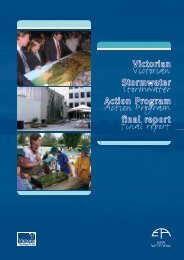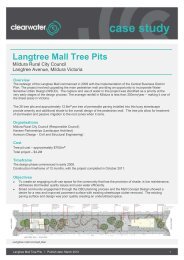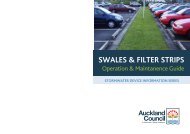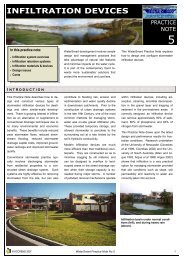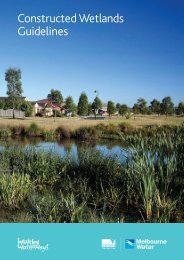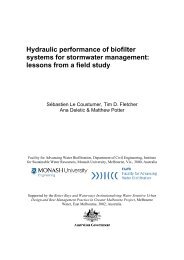CRC Street Sweep Eval 1999.pdf( 489.9 KB ) - Clearwater
CRC Street Sweep Eval 1999.pdf( 489.9 KB ) - Clearwater
CRC Street Sweep Eval 1999.pdf( 489.9 KB ) - Clearwater
You also want an ePaper? Increase the reach of your titles
YUMPU automatically turns print PDFs into web optimized ePapers that Google loves.
COOPERATIVE RESEARCH CENTRE FOR CATCHMENT HYDROLOGY<br />
Figure 7.2 Mean Inter-Event Periods for Australian Cities<br />
Of the cities analysed, Darwin shows the most interevent<br />
dry period variability between seasons, ranging<br />
between 32 hours (1.3 days) and 561 hours (23.4<br />
days), with the longer periods, unlike Melbourne,<br />
occurring during the winter months. The variable<br />
nature of inter-event dry periods, both between<br />
seasons and capital cities highlights the importance of<br />
street sweeping program design being specific to<br />
location and flexible to accommodate for season<br />
variability.<br />
Based on consideration of typical inter-event dry<br />
periods, one would question the effectiveness of<br />
current Australian street sweeping practices in<br />
effectively preventing pollutants entering the<br />
stormwater system if the street sweeping frequency,<br />
designed for aesthetic objectives, is significantly<br />
lower than the frequency of storm events. If streets<br />
are only swept every six weeks then it is likely that<br />
storm events occurring within this period will flush a<br />
large proportion of the accumulated pollutants into<br />
stormwater drains before sweeping has the<br />
opportunity to collect it. In the case of gross<br />
pollutants, Allison et al. (1998) suggested a minimum<br />
rainfall amount before there is sufficient runoff to remobilise<br />
these larger size pollutants. As a gross<br />
pollutant export control, sweeping frequency<br />
equivalent to approximately three times the mean<br />
inter-event period appears to be appropriate (see<br />
Section 8.1).<br />
<strong>Sweep</strong>ing Frequency and Rainfall Patterns:<br />
<br />
<br />
The variable nature of inter-event dry periods, both in terms of seasonal variation and dependence on<br />
climatic locations, highlights the importance of street sweeping program designs which are specific to<br />
location and flexible to accommodate the local meteorological conditions and seasonal variability.<br />
It is anticipated that if street sweeping occurs at a longer interval than the inter-event dry period of the<br />
catchment, street surface pollutants will have a much higher likelihood of being flushed into the<br />
stormwater system before being collected by the street sweeper.<br />
23




